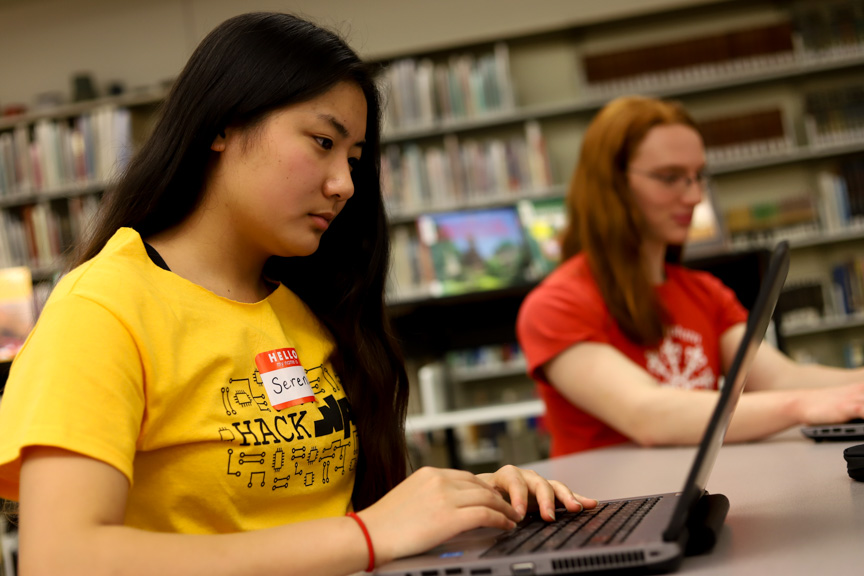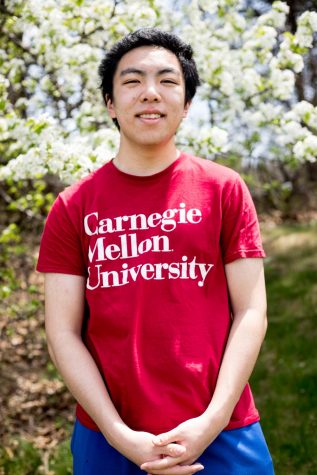Can Hack It
Young coders commandeer NASH for a Saturday of innovation
December 23, 2017
We like to relax on Saturdays. Sit on the couch, watch TV, go out with the boys, whatever. But on a Saturday last month, 133 middle and high-schoolers from 25 school districts were hard at work, building and coding at the first ever “hack”athon at NA.
For over 12 hours, over 200 participants, volunteers, and mentors immersed themselves in technology, in a world where STEM is increasingly important. All NASH computer labs were in full use, and the foreign language hallway witnessed French and Spanish replaced by Python and Javascript.
The technology takeover was the brainchild of Akshath Jain and Janet Wang, NA seniors and technology advocates. Enlisting not only the help of Mrs. Prosser, the CompSci teacher here at NASH, but also a multitude of outside sponsors, ranging from the ever-dependable Monte Cello’s to Uber, they not only covered costs but were able to provide plenty of food, beginners’ workshops, and even a hefty prize pool of $700 to be split among the top three teams.
So, you may ask, “What exactly is a hackathon?” A hackathon is a sustained period of tinkering with technology, encompassing both hardware and software. For example, teams can choose to make a remote-controlled car or write a program that scans and reads text. In competitive hackathons, there is generally a rule that you cannot enter the competition with a preexisting project, which levels the playing field and encourages creativity and innovation.
And when it came to innovation, the aspiring hackers on did not disappoint on Saturday, December 16. Operating under the theme of “may the force be with you,” teams created everything from chatroom bots to remote controlled droids. Projects that achieved finalist status included a virtual universe simulation created through incredibly advanced mathematical modeling, a machine learning algorithm used to analyze the characters of the Star Wars alphabet, and a bracelet that translated Morse code to text and speech.
It was this bracelet that won first prize. Hailing from NASH, juniors Jay Mahajan and Ethan James and senior Nick Kotte’s “Hawking Machine” brought home the first prize and 400 dollars.
When asked why they named their bracelet “The Hawking Machine”, Ethan explained, “We all know Steven Hawking needs his sophisticated wheelchair to communicate. But not everyone has access to this advanced technology, and we wanted to explore the possibilities of giving a voice to people that currently don’t have one.”
The organizers of the event also had much to say.
“As a self-proclaimed technophile, I really want to go beyond immersing just myself in technology and show others how they can become our generation’s innovators as well,” Jain said. “HackNA was a way to do this, and I’m very happy with the great display of ingenuity we saw, as well as the opportunity to mentor beginners.”
Mrs. Prosser had similar sentiments, noting that “the student organizers displayed extraordinary leadership and passion, as well as a savvy for getting sponsorships in a professional and effective manner.”
A BNY Mellon, Monte Cello’s, Uber, PPG, and Jimmy John’s for making the event possible, and encouraging technological innovation at the grassroots level.
This year’s event, sponsored by BNY Mellon, Monte Cello’s, Uber, PPG, and Jimmy John’s, was the first hackathon at NA, but Jain and Wang have plans to establish it as an annual event. Although they will have graduated next year, they do plan to pass off the responsibility to host a similar event before their departure.
“We’re already getting emails from more companies interested in sponsoring us,” Prosser said. “Hopefully, this will get bigger and bigger and maybe even inspire a new wave of interest in STEM fields in our local area.”












